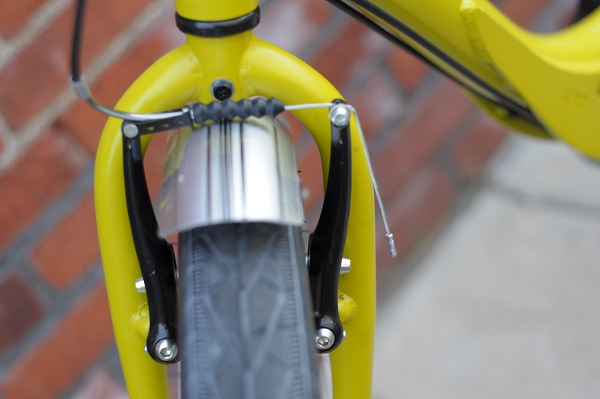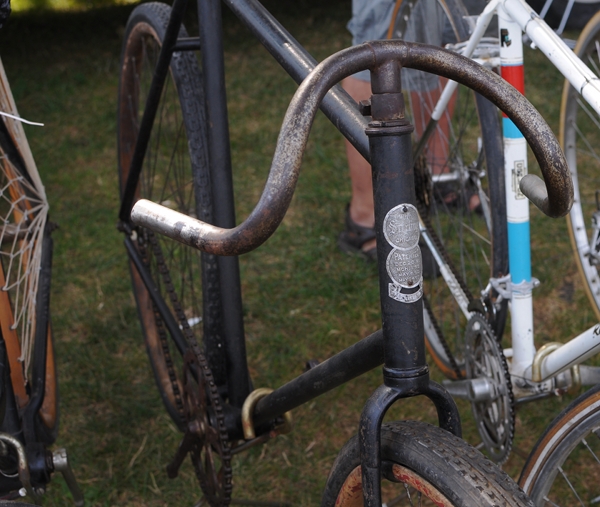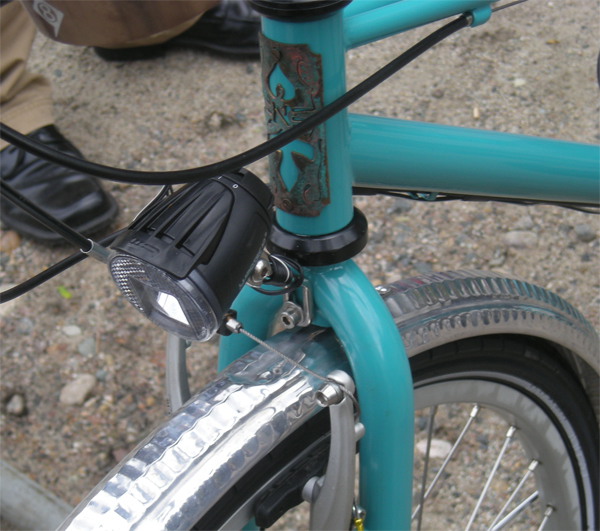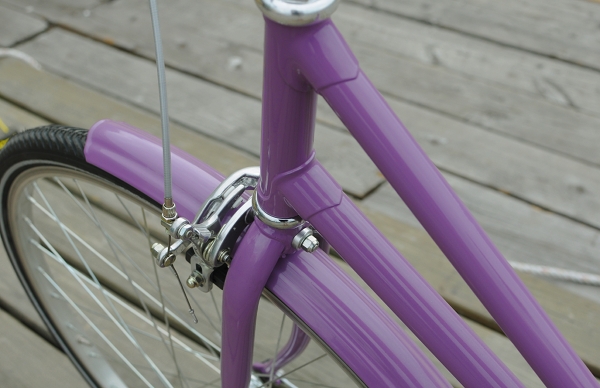 Those who have been reading this blog for some time, are no doubt familiar with my rants against unicrown forks. "The bike is nice... if it weren't for that unicrown fork," and so forth. When the topic comes up, some agree, others question my fixation on this detail, and others still want to know what a unicrown fork is. Now that I am temporarily living with a unicrown forked bike, the time seems right to elaborate.
Those who have been reading this blog for some time, are no doubt familiar with my rants against unicrown forks. "The bike is nice... if it weren't for that unicrown fork," and so forth. When the topic comes up, some agree, others question my fixation on this detail, and others still want to know what a unicrown fork is. Now that I am temporarily living with a unicrown forked bike, the time seems right to elaborate.A vey basic primer in bicycle fork construction: A traditional fork on a traditional lugged steel bike is made up of two blades and a crown, whereby the blades and crown arebrazed together - just like the tubes and lugs on the frame itself. There are many fork crown designs in existence, but the general concept is the same. Now, a unicrown fork is constructed differently in that there is no crown. The two fork blades are bent towards each other at the top, then (typically) welded together at the steerer tube. A unicrown fork is simpler and less expensive to make than a lugged crown fork, which is why it has become so ubiquitous among contemporary bicycle manufacturers.
 For some time now I've been trying to figure out the history of the unicrown fork, and I keep reading about the first mountain bikes, BMX bikes, and the quest for rigidity - suggesting that its origins were in the 1980s. But then I see antique bicycles- like this ancient Sterling pathracer at the Larz Anderson show last summer - which to me look like they are sporting hundred year old versions of unicrown forks. I have also seen what I can only describe as antique crownless flat-top forks - which appear to be similarly constructed, but are squared-off, rather than round. Would someone care to educate me on their history?
For some time now I've been trying to figure out the history of the unicrown fork, and I keep reading about the first mountain bikes, BMX bikes, and the quest for rigidity - suggesting that its origins were in the 1980s. But then I see antique bicycles- like this ancient Sterling pathracer at the Larz Anderson show last summer - which to me look like they are sporting hundred year old versions of unicrown forks. I have also seen what I can only describe as antique crownless flat-top forks - which appear to be similarly constructed, but are squared-off, rather than round. Would someone care to educate me on their history? The thing about unicrown forks, is that I don't actually dislike them per se, at least not in of themselves. What I dislike is when they are incongruent to the overall design of the bicycle. On a welded frame, a unicrown fork looks perfectly natural - integrating harmoniously with the bicycle frame. Just like I prefer lugged frames to welded frames, I similarly prefer lugged forks to unicrown forks. But objectively speaking, a unicrown fork looks fine on a welded frame - like on the D2R Boogie above.
The thing about unicrown forks, is that I don't actually dislike them per se, at least not in of themselves. What I dislike is when they are incongruent to the overall design of the bicycle. On a welded frame, a unicrown fork looks perfectly natural - integrating harmoniously with the bicycle frame. Just like I prefer lugged frames to welded frames, I similarly prefer lugged forks to unicrown forks. But objectively speaking, a unicrown fork looks fine on a welded frame - like on the D2R Boogie above. Unicrown fork on a welded DBC Swift, also looks appropriate. The frame joints and the unicrown fork match, and all are filed equally smoothly.
Unicrown fork on a welded DBC Swift, also looks appropriate. The frame joints and the unicrown fork match, and all are filed equally smoothly. Unicrown fork on an ANT mixte. Now, if I were getting an ANT, I would opt for his segmented fork or his dual-plate crown fork - just because I prefer those styles and they are kind of his specialties. But I don't think there is anything inherently wrong with ANT using unicrown forks on TIG-welded bikes - again, the overall design is harmonious.
Unicrown fork on an ANT mixte. Now, if I were getting an ANT, I would opt for his segmented fork or his dual-plate crown fork - just because I prefer those styles and they are kind of his specialties. But I don't think there is anything inherently wrong with ANT using unicrown forks on TIG-welded bikes - again, the overall design is harmonious. The only time a unicrown fork actually bothers me, is when it is attached to a lugged frame - which is done quite frequently nowadays. Azor/Workcycles puts unicrown forks on their lugged frames, as do Batavus, Velorbis (balloon tire models only) and Abici (above), just to name a few. The reason is most likely a cost-cutting measure, undertaken perhaps with the hope that most customers simply won't notice. And it bothers me, not because I think that unicrown forks in themselves are "bad," but because I feel that a traditional lugged bicycle - especially when the manufacturer takes pride in describing it as such - calls for a traditional lugged fork. When the frame is lugged but the fork is not, the overall look of the bike comes across as disjointed to me; it doesn't "flow." It's only my opinion, but I think it's a fairly simple and logical notion as far as design goes.
The only time a unicrown fork actually bothers me, is when it is attached to a lugged frame - which is done quite frequently nowadays. Azor/Workcycles puts unicrown forks on their lugged frames, as do Batavus, Velorbis (balloon tire models only) and Abici (above), just to name a few. The reason is most likely a cost-cutting measure, undertaken perhaps with the hope that most customers simply won't notice. And it bothers me, not because I think that unicrown forks in themselves are "bad," but because I feel that a traditional lugged bicycle - especially when the manufacturer takes pride in describing it as such - calls for a traditional lugged fork. When the frame is lugged but the fork is not, the overall look of the bike comes across as disjointed to me; it doesn't "flow." It's only my opinion, but I think it's a fairly simple and logical notion as far as design goes.Do you care what kind of fork your bicycle has? What do you think of unicrown forks - in of themselves, and in combination with lugged frames?
No comments:
Post a Comment